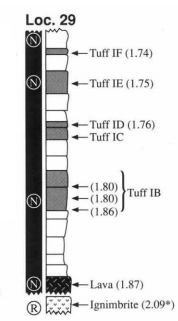 Taung, the first Australopithecus discovered, had an brain cast
Taung, the first Australopithecus discovered, had an brain cast South Africa is home of the original "missing link" of human evolution. It's where Raymond Dart found the first Australopithecus; confirming we evolved in Africa from an ape-like creature. Since then, dozens of key discoveries have come out of the " Cradle of Humankind ".
However, it seems like each discovery is raising more questions than answers. Did bury their dead? Why did walk so weird? What did the human cow eat? Clearly, our picture is incomplete and there's still a missing link or two to be found.
Now, scientists have found out why all these missing links are, well, missing! And whilst it'll likely stay that way for the forseable future 1.
The found link
We've found a lot in the more than 30 caves that make up the Cradle of Humankind. Excavations there have uncovered at least 4 human species spanning the past 3 million years, with more discoveries on the horizon. With all these finds, how can there still be a missing link?
To answer that we have to travel north to the East African Rift. This is a region that also contains dozens of hominin fossil sites from the past few million years. Like the Cradle, several new species were first found here, along with famous Lucy fossil.

However, there is one crucial difference between the two areas. The Rift is geologically active, with volcanos launching stuff across the area. Scientists can easily date these materials and, by extension, the sites where this debris lands 2.
Meanwhile, the Cradle is more geologically lazy. The caves there were formed gradually by erosion, with no volcanos mixing in datable materials. Without a solid chronology, our understanding of the Cradle remains confusing and jumbled 1.
So Robyn Pickering worked with a group of researchers from around the world to try and fix this. They began examining the calcium formations (called flowstones) produced by water dripping into caves. Thanks to advances in Uranium-lead dating we can finally figure out how old these are 1.
Now, researchers have been doing this for the past few years; already dating a few fossils from the Cradle of Humankind. However, Pickering et al. took it to the next level by dating several sites in the area with this technique. This allowed them to produce a fairly thorough chronology for the whole area 1.

The (wet) missing link
This thorough chronology would be a big deal all on its own. It provides vital context to the Cradle, helping us figure out what on earth is going on there. But as cool as that is, it wouldn't make for a sufficiently clickbaity blog headline.
The really interesting part (and cool title) comes from what isn't there. There are huge gaps between the dates they obtained, which becomes more apparent when you plot it out as a histogram. Pickering et al. were able to pull out 6 phases where these sites were occupied (marked in blue on the graph) with 7 gaps where none formed 1.

For some reason, it seems that the Cradle went uninhabited for huge swathes of time. Pickering et al. speculate that they might be drier periods, perhaps making the area uninhabitable. Or maybe sites from that period simply weren't preserved, being lost to the ravages of time 1.
Regardless, it's clear that there is a big chance for a missing link (or several) to slip through these gaps. The record of the period will be patchy and incomplete, and our understanding of evolution will remain incomplete.
And the idea of a real missing link makes for a much better blog title.
References
- Pickering, R., Herries, A.I., Woodhead, J.D., Hellstrom, J.C., Green, H.E., Paul, B., Ritzman, T., Strait, D.S., Schoville, B.J. and Hancox, P.J., 2018. U-Pb-dated flowstones restrict South African early hominin record to dry climate phases. Nature, p.1.
- Walter, R.C., Manega, P.C., Hay, R.L., Drake, R.E. and Curtis, G.H., 1991. Laser-fusion 40Ar/39Ar dating of bed I, Olduvai Gorge, Tanzania. Nature, 354(6349), p.145.

